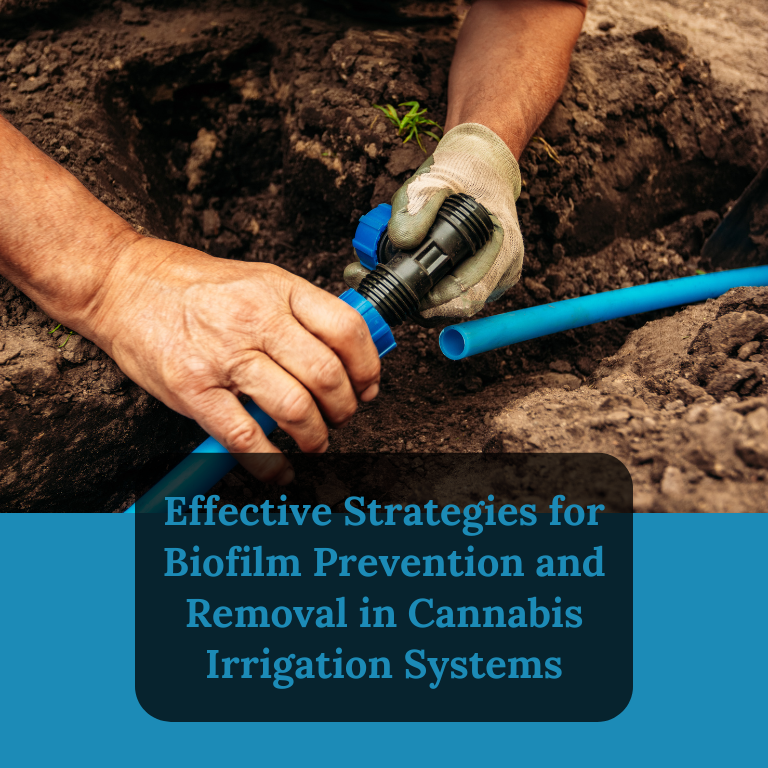Ensuring Clean Water Delivery: Strategies for Biofilm Control in Cannabis Irrigation

In cannabis cultivation, maintaining a clean and efficient irrigation system is crucial for plant health and optimal yield. One common challenge is the formation of biofilms in irrigation systems, which can hinder water flow and introduce harmful pathogens to plants. This article explores comprehensive strategies for preventing and removing biofilms in cannabis irrigation systems, ensuring the delivery of clean water to your crops.
What are Biofilms?
Biofilms are complex aggregates of microorganisms, primarily bacteria, that adhere to surfaces and produce a slimy, protective matrix. In irrigation systems, biofilms can form on the inner walls of pipes, emitters, and other components.
Impact on Cannabis Irrigation Systems
Biofilms can significantly impact irrigation systems by clogging emitters, reducing water flow, and harboring pathogens that can infect cannabis plants. This can lead to poor plant health and decreased yields.
Preventing Biofilm Formation
Designing an Effective Irrigation System: Proper system design is the first step in preventing biofilm formation. This includes using smooth, non-porous materials for pipes and components to minimize surface areas where biofilms can adhere.
Regular System Maintenance: Routine maintenance, including flushing the system with clean water and checking for any signs of biofilm formation, is essential. Regular inspections help detect and address issues before they become severe.
Water Quality Management: Ensuring the use of clean, filtered water is crucial. High-quality water reduces the introduction of organic matter and microorganisms that contribute to biofilm formation. Consider using UV sterilization or ozonation to treat the water before it enters the system.
Chemical Treatments: Periodic use of biocides or other chemical treatments can help prevent biofilm formation. However, it is important to use these treatments in a way that does not harm the plants or the environment.
Removing Existing Biofilms
Mechanical Cleaning Methods: Manual scrubbing and the use of brushes or specialized cleaning tools can physically remove biofilms from accessible areas of the irrigation system. For more extensive systems, pigging – using a specialized device to clean the inside of pipes – can be effective.
Chemical Cleaning Solutions: Several chemical solutions, such as chlorine, hydrogen peroxide, and peracetic acid, are effective at breaking down and removing biofilms. These chemicals should be used according to manufacturer guidelines to ensure safety and effectiveness.
Biological Treatments: Enzymatic cleaners and beneficial bacteria can be used to degrade biofilms without harmful chemicals. These treatments are environmentally friendly and can be an effective part of an integrated biofilm management strategy.
Best Practices for Long-Term Biofilm Control
Implementing a Regular Cleaning Schedule: Establishing and adhering to a regular cleaning and maintenance schedule is key to long-term biofilm control. Regular flushing and treatment cycles prevent the accumulation of biofilms.
Monitoring and Testing: Regularly testing water quality and monitoring the system for early signs of biofilm formation allows for prompt intervention. Advanced monitoring tools and sensors can help detect biofilm presence and water flow issues in real-time.
Training and Education: Ensuring that all personnel involved in the cultivation process are trained in biofilm prevention and removal techniques is crucial. Knowledgeable staff can identify and address issues more effectively.
Advantages of Clean Irrigation Systems
Improved Plant Health: A clean irrigation system ensures that cannabis plants receive uncontaminated water, reducing the risk of disease and promoting healthier growth.
Enhanced Yield: Preventing biofilms improves water and nutrient delivery efficiency, leading to better plant development and higher yields.
Cost Savings: Regular maintenance and biofilm management reduce the risk of system failures and costly repairs, leading to long-term cost savings.
Effective biofilm prevention and removal in cannabis irrigation systems are essential for maintaining plant health and maximizing yield. By implementing a combination of system design, regular maintenance, water quality management, and appropriate cleaning methods, cultivators can ensure clean water delivery to their crops. Adhering to these strategies not only enhances the overall efficiency of the irrigation system but also contributes to the success and profitability of cannabis cultivation.











